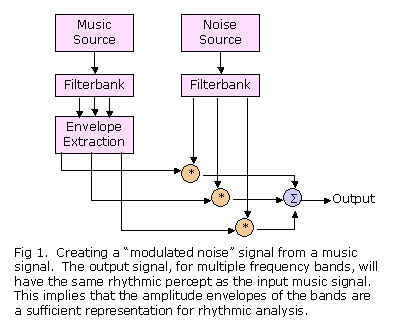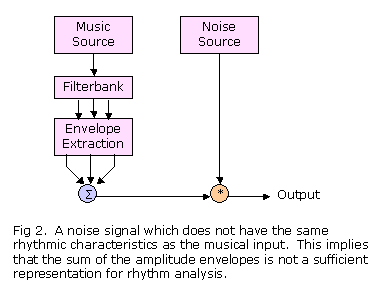 |
Background
A key motivation of our project was to model the human
perception of beat. Our algorithm will try to "perceive"
the pulse content of a musical signal in ways similar to
the human ear. Due to certain psychoacoustic
characteristics of humans, we can make many
simplifications in our processing of musical signals
without affecting the rhythmic content.
Previous research has determined that a modulated noise
signal created from a musical signal has a very similar
rhythmic percept as the original signal.
 This process
preserves only the individual amplitude envelopes
resulting from dividing the signal into various frequency
bands. Such results imply that the subband envelopes
are sufficient for reasonable beat detection. Other
information, such as the individual "notes" of a
song, is not needed and thus greatly reduces the amount of
data processing.
This process
preserves only the individual amplitude envelopes
resulting from dividing the signal into various frequency
bands. Such results imply that the subband envelopes
are sufficient for reasonable beat detection. Other
information, such as the individual "notes" of a
song, is not needed and thus greatly reduces the amount of
data processing.
However, research has also shown that other
simplifications do not allow for accurate beat detection.
For example, too much information is lost by only using
one frequency band. In addition, if attempts are made to
sum the different subband envelopes before noise
modulation, then the rhythmic characteristics of the
output will no longer be accurate.

Therefore, the
conclusion is made that dividing the signal into diffent
frequency bands and processing each band separately yields
accurate beat detection results. This implies that the
human auditory system does not simply sum signals across
different frequencies, but performs more complicated
processing.
|